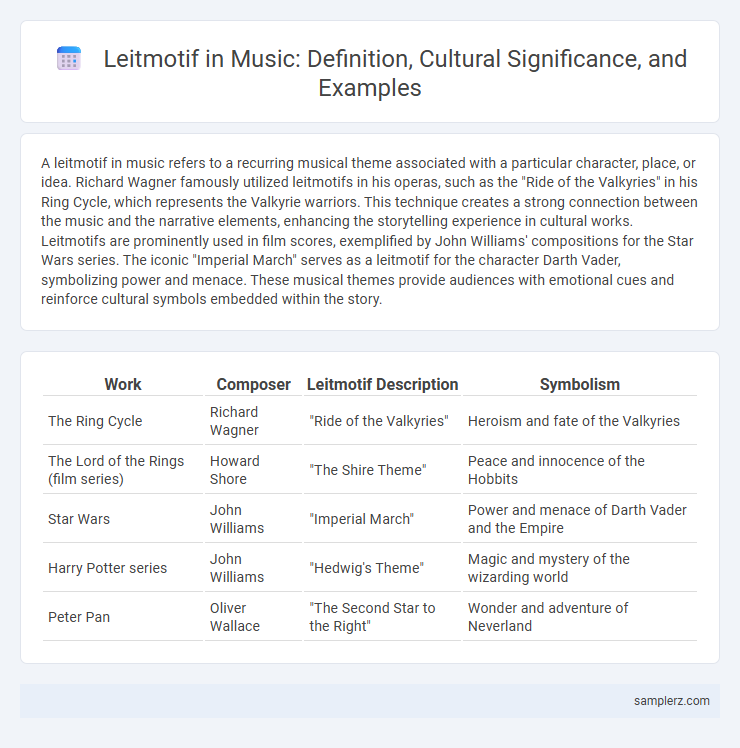A leitmotif in music refers to a recurring musical theme associated with a particular character, place, or idea. Richard Wagner famously utilized leitmotifs in his operas, such as the "Ride of the Valkyries" in his Ring Cycle, which represents the Valkyrie warriors. This technique creates a strong connection between the music and the narrative elements, enhancing the storytelling experience in cultural works. Leitmotifs are prominently used in film scores, exemplified by John Williams' compositions for the Star Wars series. The iconic "Imperial March" serves as a leitmotif for the character Darth Vader, symbolizing power and menace. These musical themes provide audiences with emotional cues and reinforce cultural symbols embedded within the story.
Table of Comparison
| Work | Composer | Leitmotif Description | Symbolism |
|---|---|---|---|
| The Ring Cycle | Richard Wagner | "Ride of the Valkyries" | Heroism and fate of the Valkyries |
| The Lord of the Rings (film series) | Howard Shore | "The Shire Theme" | Peace and innocence of the Hobbits |
| Star Wars | John Williams | "Imperial March" | Power and menace of Darth Vader and the Empire |
| Harry Potter series | John Williams | "Hedwig's Theme" | Magic and mystery of the wizarding world |
| Peter Pan | Oliver Wallace | "The Second Star to the Right" | Wonder and adventure of Neverland |
Defining Leitmotif: Origins and Meaning in Music
Leitmotif, a recurring musical theme associated with a particular character, place, or idea, originated in the 19th century through the operatic works of Richard Wagner. This technique serves as a sonic identifier that enhances narrative coherence and emotional depth within compositions. Wagner's use of leitmotifs in operas like "Der Ring des Nibelungen" revolutionized thematic development by linking music directly to storytelling elements.
Richard Wagner: Pioneer of Leitmotif Technique
Richard Wagner revolutionized opera with his innovative use of leitmotifs, recurring musical themes representing characters, emotions, or ideas. This technique, prominently featured in his epic cycle "Der Ring des Nibelungen," creates a complex narrative web that enhances dramatic cohesion and emotional depth. Wagner's pioneering work established leitmotifs as a fundamental tool in music composition, influencing countless composers across various genres.
Leitmotifs in Classical Opera: Iconic Examples
Leitmotifs in classical opera serve as recurring musical themes representing characters, emotions, or ideas, enhancing narrative depth and emotional resonance. Wagner's "Ring Cycle" features some of the most iconic leitmotifs, such as the "Siegfried motif" symbolizing heroism and the "Valhalla motif" evoking the gods' realm. Verdi's operas, including "Rigoletto," utilize leitmotifs like the curse theme to subtly reinforce plot elements and character motivations throughout the performance.
The Use of Leitmotif in Film Scores
Leitmotifs in film scores function as recurring musical themes that represent characters, locations, or ideas, enhancing narrative coherence and emotional depth. Iconic examples include John Williams' use of distinct motifs in the Star Wars saga, where themes like the Force motif symbolize heroism and destiny. This technique creates an aural connection that helps audiences intuitively follow story arcs and character development.
Recurring Melodies: Leitmotif in Modern Video Games
Leitmotifs in modern video games function as recurring melodies that reinforce narrative themes and character identity, as seen in franchises like The Legend of Zelda and Final Fantasy. These motifs enhance player immersion by triggering emotional responses linked to specific story elements or characters. By repeating and varying these musical elements, game composers create a cohesive auditory experience that deepens engagement and storytelling.
Leitmotif in Popular Music: Subtle and Overt Uses
Leitmotifs in popular music serve as recurring themes that reinforce characters, emotions, or ideas, often enhancing storytelling in songs and albums. Subtle uses include thematic motifs woven into background instrumentation or melodic fragments, as seen in The Beatles' "Sgt. Pepper's Lonely Hearts Club Band," where musical phrases reappear to unify the album's concept. Overt examples are evident in film soundtracks like John Williams' work for Star Wars, where distinctive leitmotifs symbolize characters or locations, illustrating the technique's impact beyond classical compositions into mainstream culture.
Leitmotif and Character Development in Musicals
Leitmotifs in musicals function as recurring musical themes associated with specific characters, enhancing narrative depth and emotional resonance. For example, Stephen Sondheim's use of leitmotifs in *Sweeney Todd* reveals character psychology and growth through subtle melodic variations. These thematic elements allow composers to underscore internal conflicts and transformations, creating a rich, cohesive storytelling experience.
Cross-Cultural Variations of Leitmotif Traditions
Leitmotifs in music vary significantly across cultures, with Western classical traditions exemplified by Wagner's use in operas, while Japanese Noh theater employs melodic fragments tied to character archetypes. Indian classical music incorporates recurring ragas that function as cultural leitmotifs, evoking specific emotions and spiritual themes unique to the region. African musical traditions often use repetitive rhythmic patterns as leitmotifs, connecting community identity and storytelling in diverse tribal contexts.
Psychological Impact of Leitmotif on Audiences
Leitmotifs in music, such as Wagner's recurring themes in his operas, create strong emotional associations that enhance audience engagement by triggering subconscious recognition and memory recall. These repeated musical phrases evoke specific emotions and character identities, deepening psychological immersion and reinforcing narrative coherence. The strategic use of leitmotifs influences audience anticipation and empathy, intensifying the overall psychological impact of the performance.
The Evolution of Leitmotif in Contemporary Culture
Leitmotifs, originally popularized by Richard Wagner in 19th-century operas, have evolved to become a staple in modern film and video game scores, serving as recurring themes that represent characters, ideas, or settings. In contemporary culture, composers like John Williams and Howard Shore use leitmotifs to enhance narrative depth and emotional resonance, embedding musical motifs that audiences instantly associate with specific story elements. This evolution showcases how leitmotifs function as powerful storytelling tools, bridging classical compositional techniques with modern multimedia experiences.

example of leitmotif in music Infographic
 samplerz.com
samplerz.com